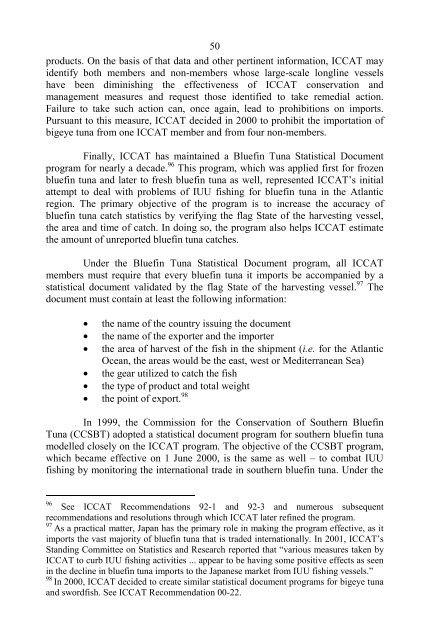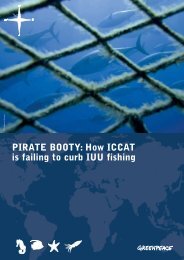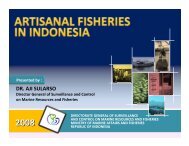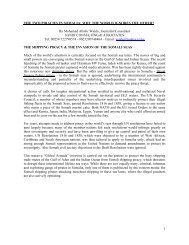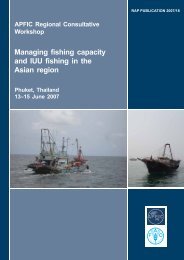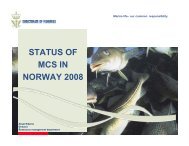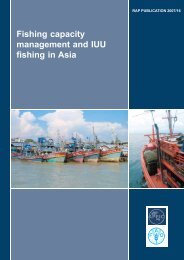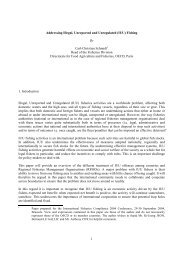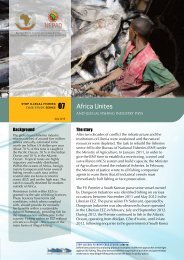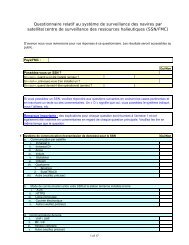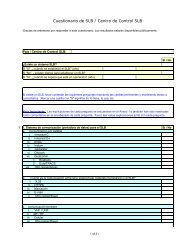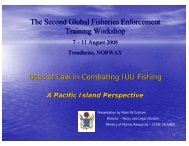Implementation of IPOA/IUU - International MCS Network
Implementation of IPOA/IUU - International MCS Network
Implementation of IPOA/IUU - International MCS Network
Create successful ePaper yourself
Turn your PDF publications into a flip-book with our unique Google optimized e-Paper software.
50products. On the basis <strong>of</strong> that data and other pertinent information, ICCAT mayidentify both members and non-members whose large-scale longline vesselshave been diminishing the effectiveness <strong>of</strong> ICCAT conservation andmanagement measures and request those identified to take remedial action.Failure to take such action can, once again, lead to prohibitions on imports.Pursuant to this measure, ICCAT decided in 2000 to prohibit the importation <strong>of</strong>bigeye tuna from one ICCAT member and from four non-members.Finally, ICCAT has maintained a Bluefin Tuna Statistical Documentprogram for nearly a decade. 96 This program, which was applied first for frozenbluefin tuna and later to fresh bluefin tuna as well, represented ICCAT’s initialattempt to deal with problems <strong>of</strong> <strong>IUU</strong> fishing for bluefin tuna in the Atlanticregion. The primary objective <strong>of</strong> the program is to increase the accuracy <strong>of</strong>bluefin tuna catch statistics by verifying the flag State <strong>of</strong> the harvesting vessel,the area and time <strong>of</strong> catch. In doing so, the program also helps ICCAT estimatethe amount <strong>of</strong> unreported bluefin tuna catches.Under the Bluefin Tuna Statistical Document program, all ICCATmembers must require that every bluefin tuna it imports be accompanied by astatistical document validated by the flag State <strong>of</strong> the harvesting vessel. 97 Thedocument must contain at least the following information: the name <strong>of</strong> the country issuing the document the name <strong>of</strong> the exporter and the importer the area <strong>of</strong> harvest <strong>of</strong> the fish in the shipment (i.e. for the AtlanticOcean, the areas would be the east, west or Mediterranean Sea) the gear utilized to catch the fish the type <strong>of</strong> product and total weight the point <strong>of</strong> export. 98In 1999, the Commission for the Conservation <strong>of</strong> Southern BluefinTuna (CCSBT) adopted a statistical document program for southern bluefin tunamodelled closely on the ICCAT program. The objective <strong>of</strong> the CCSBT program,which became effective on 1 June 2000, is the same as well – to combat <strong>IUU</strong>fishing by monitoring the international trade in southern bluefin tuna. Under the96See ICCAT Recommendations 92-1 and 92-3 and numerous subsequentrecommendations and resolutions through which ICCAT later refined the program.97 As a practical matter, Japan has the primary role in making the program effective, as itimports the vast majority <strong>of</strong> bluefin tuna that is traded internationally. In 2001, ICCAT’sStanding Committee on Statistics and Research reported that “various measures taken byICCAT to curb <strong>IUU</strong> fishing activities ... appear to be having some positive effects as seenin the decline in bluefin tuna imports to the Japanese market from <strong>IUU</strong> fishing vessels.”98 In 2000, ICCAT decided to create similar statistical document programs for bigeye tunaand swordfish. See ICCAT Recommendation 00-22.


